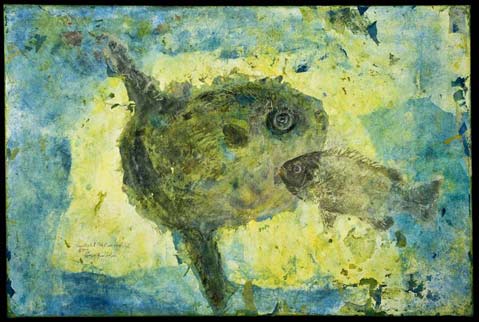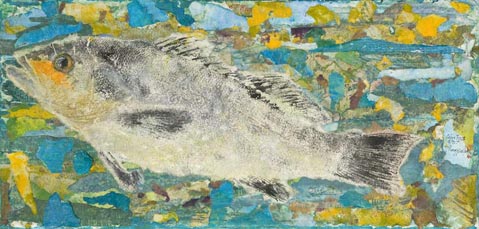Water and Earth: Works by Craig Rudholm
Japanese-Style Fish Prints at Muddy Waters

Stepping inside Muddy Waters this month is a little like walking into a giant aquarium. The walls of the bohemian Haley Street café are lined with colorful, mixed-media works, each of which takes fish as its primary subject.
These are more than artistic representations; they’re actually prints made in one of two ways: either by applying color to the fish and pressing fabric or paper against it, or by laying a cloth against the body of the fish and applying paint to the thin material using the body as a guide. Craig Rudholm has been making fish prints for more than a decade, and he often uses handmade paper. His techniques are influenced by gyotaku—the Japanese tradition of printmaking used to record fishermen’s catches—but Rudholm goes far beyond cataloguing. In these works, bass, rockfish, and cod become characters in their own enigmatic, watery dramas.

In “Calico Bass” (2007), the fish nearly fills the one-by-two-foot canvas, floating against a liquid ground of blues and golden yellows. For the sheer size of their subjects, works like this and “Large Mouth Bass” (2006) could hang alongside deer antlers on a wall of hunting and fishing trophies, but for the tranquil, almost reverent presentation of each animal in its underwater world. They’re only fish, after all—mouths slightly agape, wide eyes staring, feathery fins protruding from their tails and beneath their gills—but Rudholm’s understated compositions reveal each fish as a magnificent and mysterious creature.
“Sunfish and Tahitian Reef Fish” (2007) captures the tension between two species; one seems about to devour the other. A few works from 2008, including the vivid yellow “Dinner Dreams” and the murkier “Boccacio and Woman,” include tantalizing collage fragments of human figures. The latter veers into abstraction, splatters of paint and shards of blue plastic littering its surface, while a torn black-and-white photograph at its center includes a woman’s face in profile. The presence of humans in these works is jarring—what are a miniature mother and child in lace-up boots and full skirts doing here?—yet they are ultimately minor distractions from something much brighter, grander, and more enduring.
Most of these works measure somewhere in the range of two-by-three-feet and contain a couple of figures, but there are exceptions: “Black Cod Forgetting How to Swim” is more of a deep sea dreamscape, its central figure cutting a sharp diagonal as if diving or sinking, with shadowy fish heads emerging from the dark blue depths. At 40 square inches, it’s a full-size window into an archetypal underworld.



